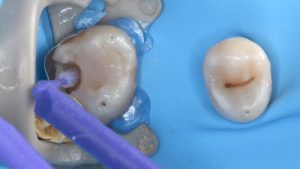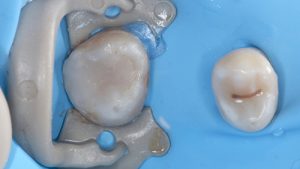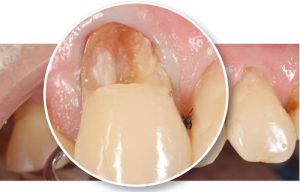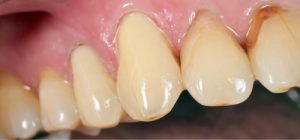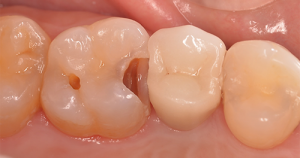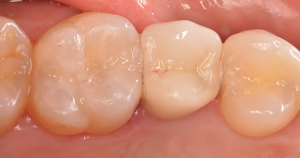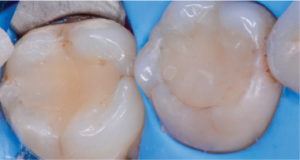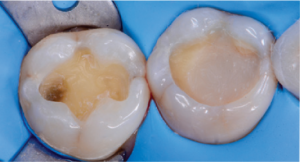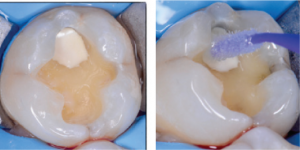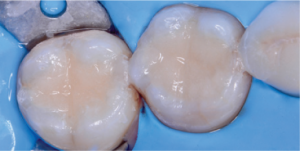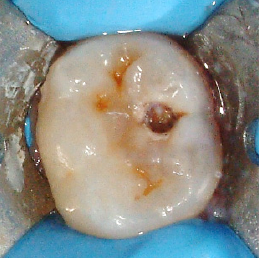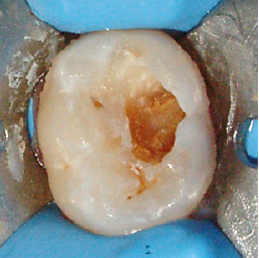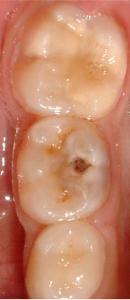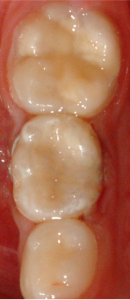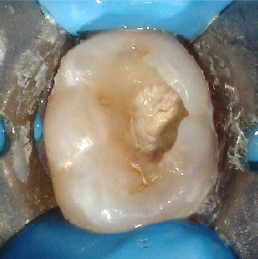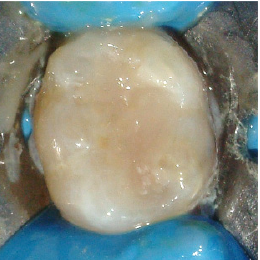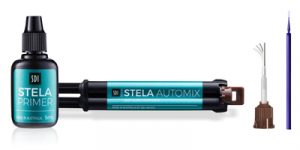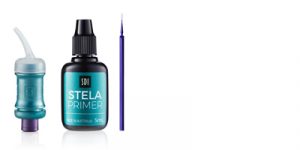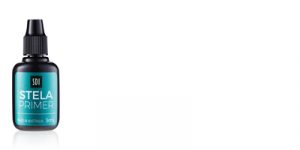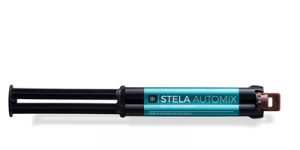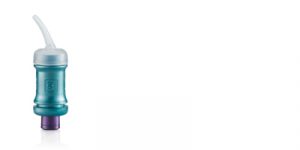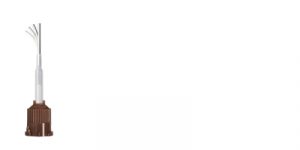The future of composites
Compressive
Strength

Flexural
Strength
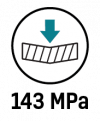
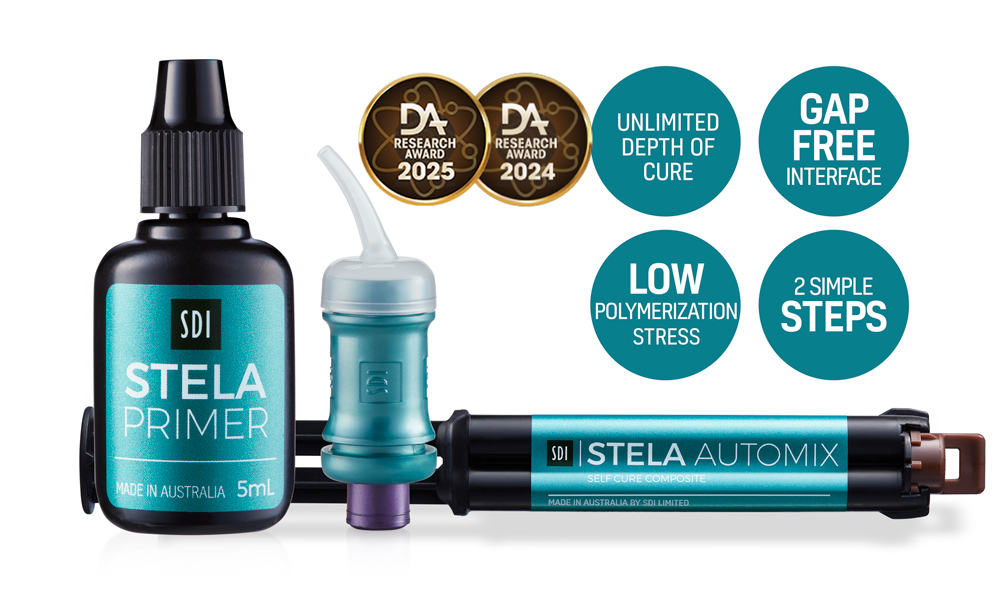

“The combination of Stela Primer and the self-curing Stela restorative generates low polymerization stress, which enables this bulk-fill composite system to create a gap-free bonding interface.”
 Prof Dr SALVATORE Sauro
Prof Dr SALVATORE Sauro
Stela is an innovative high-performance self-cure composite. Stela offers an unlimited depth of cure and low-stress polymerization with a gap-free interface. There is no need to acid etch or light cure.
Stela achieves its ground-breaking properties through a tailored combination of BPA-free resin monomers, optimized ionglass™ fillers (SDI’s bioactive proprietary hybrid glass), and specially surface-modified nanoparticles of amorphous silica. Stela’s outstanding mechanical properties come from a rapid curing reaction. The Stela monomers form polymeric chains and, simultaneously, these chains are rapidly and densely cross-linked to each other, forming a complex web that strongly binds the ionglass™ filler and the amorphous silica, resulting in a strong and resilient restorative material.
The Stela snap set fast cure is due to an innovative hydroperoxide-based initiation system that is free of tertiary amine. This ensures fast-setting characteristics, good color stability and an excellent conversion rate.
Once cured, Stela’s matrix delivers consistent and reliable strength and durability for all restorations. The simple two step process minimizes operator errors and patient sensitivity with no etch or curing lights required. Stela is the solution for all your clinical needs
Stela is available in two delivery systems: Stela Capsule and Stela Automix syringe.
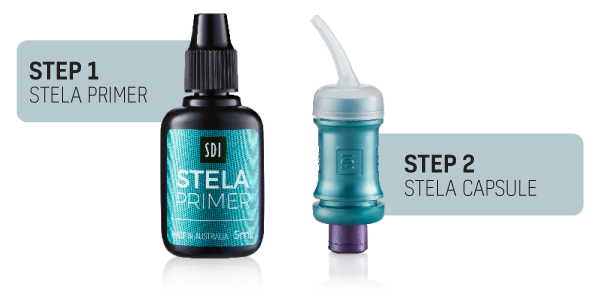
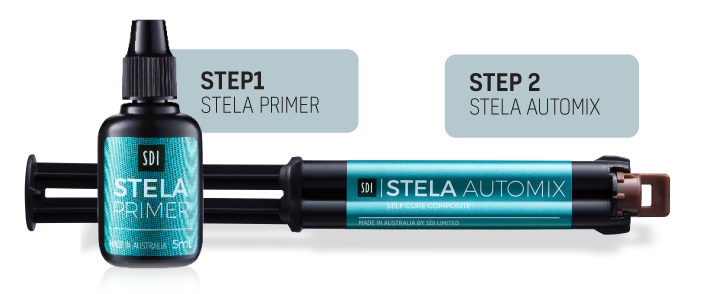
A Stronger Bond Without Gaps
Study: No Interface Gaps
An external study demonstrated Stela’s high bond strength to dentine. Micrograph imagery showed interfaces without defects or gaps. The study noted that “Filtek One Bulk-Fill presented the lowest results, with resin dentine interfaces characterized by gaps and porosities.” In contrast, Stela “…exhibited better interfacial adaptation and greater bonding performance compared to universal and bulk-fill composites.”
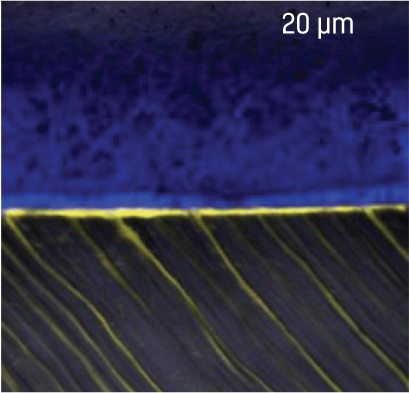
Stela bonding interface (Self etch)
A confocal micrograph of a gap-free
Stela-dentine interface, using the self etch Stela Primer.
Note the penetration depth of Stela Primer (yellow) within the dentine tubules.
Pre-test failure rate: 0%
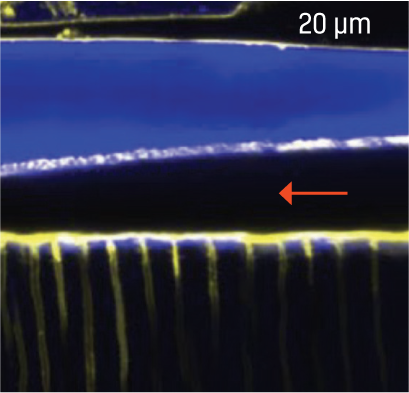
Filtek One Bulk Fill (Self etch)
A confocal micrograph showing the dentine interface of Filtek One Bulk-Fill (3M ESPE), in self etch mode. The red arrow shows the presence of gaps.
Pre-test failure rate: 75%
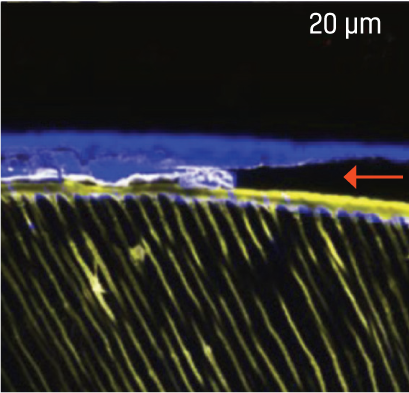
Filtek One Bulk Fill (Etch & rinse)
A confocal micrograph showing the dentine interface of Filtek One Bulk-Fill (3M ESPE), in etch & rinse mode. The red arrow shows the presence of gaps.
Pre-test failure rate: 10%
SOURCE: SAURO, Salvatore et al. 2022. Microtensile bond strength and interfacial adaptation of two bulk-fill composites compared to a conventional composite restorative system
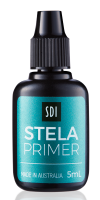
“[Stela] performs as well as market-leading universal and bulk-fill composites bonded to dentine with universal adhesives. Moreover, in this study, [Stela] exhibited better interfacial adaptation and greater bonding performance compared to universal and bulk-fill composites.”
Paula Maciel Pires & Aline de Almeida Neves (Federal University of Rio de Janeiro)
Filippo Semenza & Salvatore Sauro (Cardenal Herrera CEU University)
International Association for Dental Research, Asia, 2022.
Standard etch-prime-bond-cure combinations are time-consuming and technique sensitive, introducing the potential for contamination and errors, leading to sensitivity and premature failure.
The Stela Primer was developed in tandem with Stela Capsule and Stela Automix syringe. Together, the formulations combinate to deliver an increased bond strength compared to standard etch-prime-bond products~.
Both Stela Primer and Stela composite have the MDP monomer, ensuring a strong chemical bond, free of gaps, with better sealing for durability and no sensitivity.
Stela Primer tags into the dentinal tubules, forming micromechanical retentions (secondary bond).
Stela Primer then chemically bonds to Stela paste (primary bond), forming a true adhesion between atoms or molecules of Primer and composite.
Gap-Free Interface
Stela Cures From The Margins, Not From The LED Curing Light
Light cure composite polymerization begins in the area closest to the light source, before progressing deeper into the restoration.1, 3 The resulting polymerization shrinkage pulls the restorative from the cavity walls and creates micro gaps.2
These gaps can frequently cause post-operative sensitivity, marginal leakage with staining, and recurrent caries.1, 2, 3</sup
Stela’s self-cure polymerization begins from the applied Stela Primer on the cavity walls, as the primer contains a catalyst. This polymerization sequence microscopically pulls the restorative towards the cavity – and not away from it, providing you with gap-free restorations every time reducing the risk of sensitivity and premature failure.
- Hamdi Hosni Hamama. Recent advances in posterior resin composite restorations in Applications of Nanocomposite Materials in Dentistry, 2019.
- S.R. Schricker. Composite resin polymerization and relevant parameters in Orthodontic Applications of Biomaterials, 2017.
- Gary S. Berkowitz et al. Postoperative Hypersensitivity and Its Relationship to Preparation Variables in Class I Resin-Based Composite Restorations: Findings from the Practitioners Engaged in Applied Research and Learning (PEARL) Network. Part 1. Compend Contin Educ Dent. 2013 Mar; 34(3): e44–e52.
Light Cure Polymerization
Marginal gaps: LED polymerization results in pull-stress along the deepest margins, leading to micro gaps.
Uncured composite: Composites cannot self cure. If a restoration is angled or difficult to access, the uncured composite may prematurely fail.
Sensitivity: Uncured composite, micro gaps, multi-step techniques, and prolonged in-chair time put patients at a greater risk of postoperative sensitivity.
Depth limit: Most composites are limited to 2mm depth of cure. Deeper restorations require additional time.
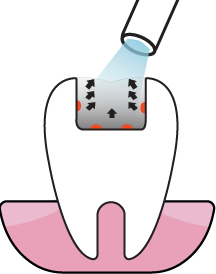
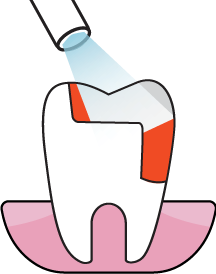
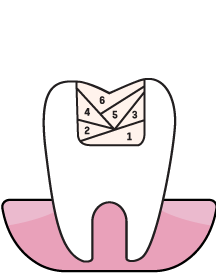
VS
Stela Polymerization
Low stress curing: Stela paste polymerizes faster along the walls when contacting with Stela Primer. This polymerization sequence provides a gap-free restoration.
Zero LED curing complications: Without a collimated beam, many curing lights are limited in their ability to fully cure composite in deep cavities and large restorations. Stela eliminates the need for LED curing and the potential for uncured resin, sensitivity, and premature failure.
Reduced technique errors: With fewer steps, there is less chance of contamination and operator errors, providing you more clinical certainty.
Unlimited depth of cure: Stela is a new generation of composites that will self cure to an unlimited depth. This gives you full cure certainty for all restorations.
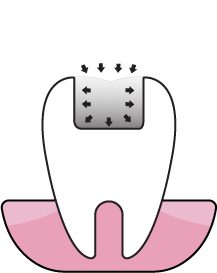
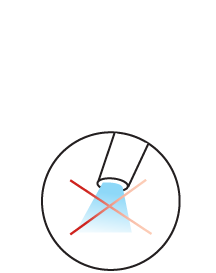
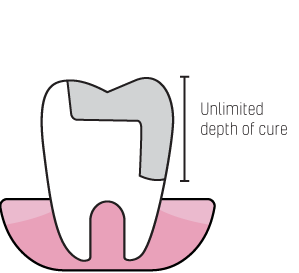
The Stronger Restorative
Stronger Than Composites
The strength of a restorative should always be judged on its combination of compressive and flexural properties, to resist occlusal forces and to prevent fractures during function.
Stela has the perfect balance of two strengths, outperforming most other composite products.
Source: Manufacturers brochures for non-SDI products and SDI Research & Development Department for Stela.
*Not a registered trademark of SDI. ^ Stela Automix
Fewer Steps, Fewer Failures
Stela Primer revolutionizes the etch, prime and bond system, while delivering a better bond strength.
While other etch, prime and bond systems require up to 7 steps and 90-120 seconds to complete, the Stela Primer system is complete in only two steps and 15 seconds. Fewer steps means fewer opportunities for errors and longer lasting restorations.
Reduce your in-chair time and eliminate potential technique sensitivity with the simplified Stela technique.



Faster, Simpler Restorations
Unlimited Bulk Fill With Certainty
Composite restorations fail for a variety of reasons, including uncured material in deep areas, which may cause sensitivity. Stela will self-cure at all depths, thereby eliminating any curing uncertainty.
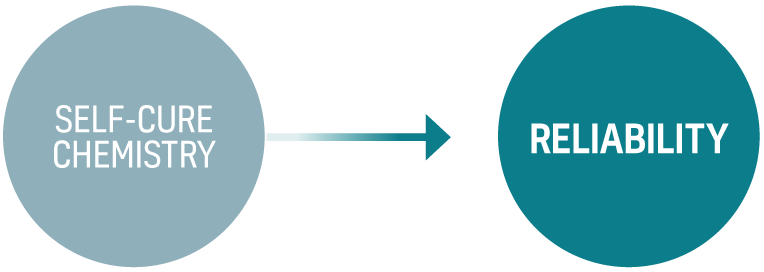

“Stela offers excellent working time and is very easy to manipulate.”
 Prof Dr Alessandro Loguercio
Prof Dr Alessandro Loguercio
DDS, Ms, PhD, Professor at the State University of Ponta Grossa, Brazil
Faster With Chameleon Aesthetics
A 50% Faster Self Cure
Stela has a faster self cure setting time than two other leading restoratives. Stela Capsule and Stela Automix syringe both offer a comfortable working time of ≥ 1 minute and 30 seconds. Restorations are ready for finishing and polishing in 4 minutes from the start of the mixing time.
This 50% time saving increases your treatment efficiency. Such efficiency is multiplied when restoring multiple cavities consecutively.
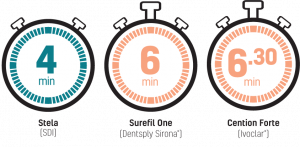
Source: Manufacturers brochures for non-SDI products and SDI Research & Development Department for Stela.
*Not a registered trademark of SDI.
Translucency and Opacity
A bulk fill composite generally has opacity limitations to allow light to penetrate more deeply.
Stela does not need a curing light and offers a balance between translucency and opacity for most posterior teeth. Its universal shade with chameleon effect blends in with surrounding structures, blocking stains like a dentine replacement and sealing edges for a flawless finish that mimics enamel.
Stela offers an unlimited depth of cure without compromising aesthetics.
No Tertiary Amine For Improved Color Stability
Most self cure composites contain tertiary amine. This additive can contribute to long term shade darkening and the yellowing of restorations.1,2 Tertiary amine can also reduce the longevity of adhesion to dentine as the composite restoration ages.2
Stela has been formulated without tertiary amine. This provides you improved long term aesthetic stability while maintaining bond strength.
1.Andrea Kowalska et al. The Photoinitiators Used in Resin Based Dental Composite – A Review and Future Perspectives, 2021.
2 Andrea Kowalska et al. Can TPO as Photoinitiator Replace “Golden Mean” Camphorquinone and Tertiary Amines in Dental Composites?, 2022.
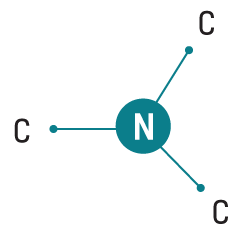

Drawing on 50 years of dental research experience, SDI’s ionglass™ filler is manufactured in Australia by our glass experts. The ionglass™ technology mimics the natural tooth structure, guaranteeing restorations will withstand long term mastication forces and patients will be satisfied with the treatment. Stela contains ionglass™ filler, a bioactive proprietary hybrid glass made of a unique blend of different sizes of ultrafine highly reactive particles.
Superior Handling
Stela offers two handling options, both of which have been formulated to give you outstanding control compared to other leading restoratives.
Stela Automix syringe includes rotating and bendable metal tips. This allows precise extrusion in the most hard-to-access places.
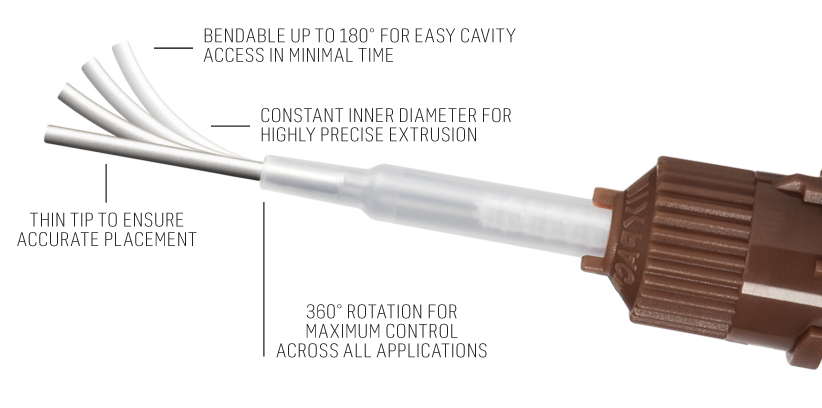
Viscosity Test
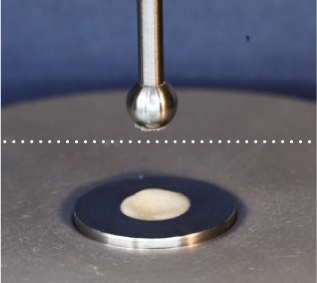
Stela Capsule
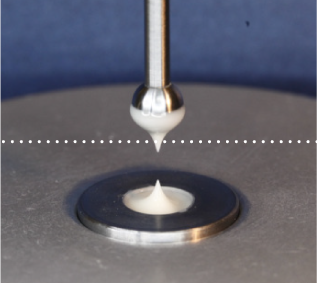
Stela Automix
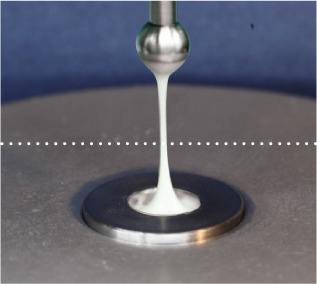
Equia Forte HT (GC)*
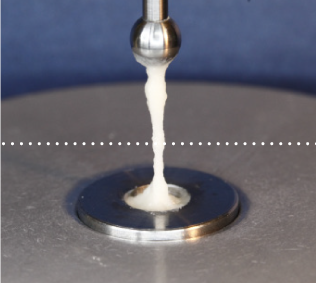
Cention Forte (Ivoclar)*
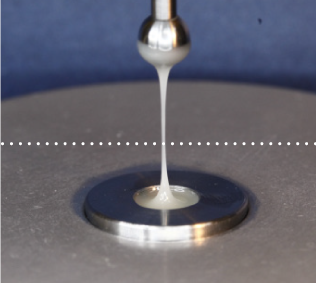
Filtek Bulk Fill Flowable (3M)*

Surefil One (Dentsply Sirona)*
*Not a registered trademark of SDI.



FLUORIDE, CALCIUM AND STRONTIUM
Stela contains fluoride, calcium and strontium for enhanced biomimetic and bioactive properties, adding an extra layer of protection during acid challenge.
Truly An Amalgam Alternative
An “Amalgam Alternative”
Is A Bold Claim. Is It True?
Many products claim to be an amalgam alternative, but fail comparisons based on strength, marginal sealing and depth of cure. Stela has been formulated specifically as a restorative that can be used as an amalgam alternative, with the advantage of having a lifelike aesthetic result in a cavity without mechanical retentions. Stela is available in a universal shade that blends to surrounding tooth areas with a chameleon effect.
Snapset Strength In Minutes
Restoratives harden over time until they reach their final strength. Stela is formulated to reach a high strength as quickly as possible, allowing finishing and polishing in just 4 minutes. After this initial set, Stela becomes a strong composite that easily exceeds the properties of alternatives.
While amalgam achieves only 37% of its final strength in 60 minutes, Stela achieves 90% strength in the same 60 minute period.
Stela’s snapset strength reduces premature failures during the critical first 24 hour period, decreasing patient returns and re-work.
Stela also offers great value. One capsule of Stela has more volume than a 3-spill amalgam capsule, which is enough for large restorations.

“SDI founder Jeff Cheetham has manufactured more amalgam products than almost anyone else in the world. According to Jeff “Amalgam is so strong and easy to place. No etching, no layering, no light cure. That is the basis of Stela. The world is rapidly moving away from amalgam and that is why we mobilized our 50 years of amalgam knowledge behind developing Stela. Stela truly is the new amalgam alternative.”
Jeffrey Cheetham, SDI Chairman and founder
Comparison to Amalgam
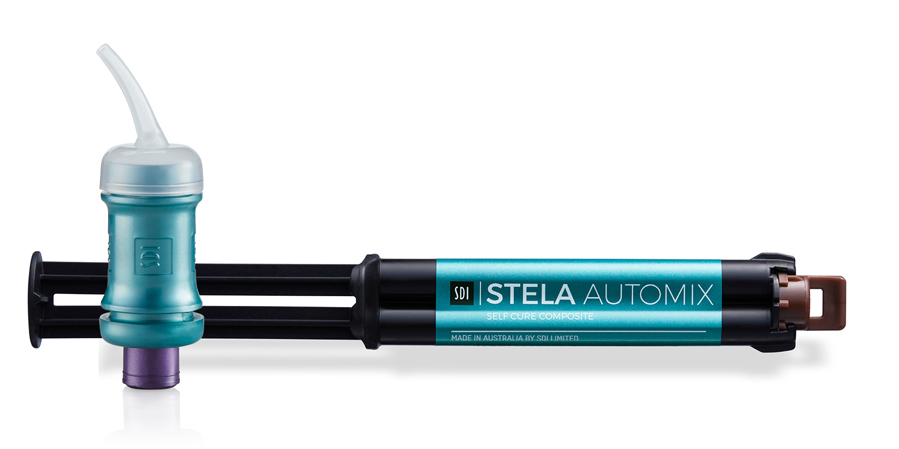
| Amalgam | Stela | |
| Mercury | Contains mercury | Mercury free |
| Technique sensitivity | Higher | Lower |
| Tooth preparation | Retentive cavity | Cavity without mechanical retentions |
| Depth of cure | Unlimited | Unlimited |
| Aesthetics | Poor | Very good |
| Radiopacity | Very high | Very high |
| Dispensing system | Capsule | Capsule or Automix syringe |
| Working time | Up to 10 min 15 sec (condensing and carving) |
≥1 min 30 sec (inserting into the cavity) |
| Snapset strength | ~90% strength after 24 hours | ~90% strength after 60 minutes |
| Finishing and polishing | Requires a second appointment | Within same appointment |
Multi-Year Research Partnership
Stela technology is the outstanding result of a partnership between SDI scientists – with half a century of experience developing dental materials – and engineers from the University of New South Wales (UNSW), the University of Sydney, and the University of Wollongong. These three world leading Australian universities have over 170 years of combined experience researching high-performance industrial composites, among other materials. This collaboration created Stela, a high-performance dental composite. The SDI and UNSW partnership that led to the Stela breakthrough technology also produced multiple scientific journal and conference papers.^
^ This project received grant funding from the Australian Government through the CRC Program

“The scientific collaboration between interdisciplinary composites researchers at UNSW and SDI scientists became the commercialization vehicle for the development of advanced biomaterials and technologies.”
 Prof Gangadhara Prusty
Prof Gangadhara Prusty
Director, ARC Training Center for Automated Manufacture of Advanced Composites, School of Mechanical & Manufacturing Engineering, UNSW SYDNEY, Australia

“The SDI team, working closely with our multifunctional composites team at UNSW, has set the stage for launching a new frontier of restorative composites.”
 Dr Raju
Dr Raju
Center Manager, ARC Training Center for Automated Manufacture of Advanced Composites, School of Mechanical & Manufacturing Engineering, UNSW SYDNEY, Australia
The last 10 years of restorative development has delivered only minor improvements. This is because new restoratives focus only on the material and neglect the surrounding steps in the restorative process. Stela is the complete end-to-end composite system that delivers easier and stronger gap-free restorations. This provides you with clinical certainty every time.




Particle Size & Distribution
Composite fillers can be very different from each other. High strength, low abrasion and excellent polishability depend not only on the size of the glass filler particles, but also on the concentration of each size in the formulation.
In a constant search for innovation, SDI scientists improved the distribution of different sizes of Stela fillers, combined with nanoparticles of amorphous silica, resulting in first-class mechanical properties and fast and long lasting polishability, associated with very low wear.
| Physical Property | Stela Capsule* | Stela Automix* |
| Compressive strength (MPa) (24hrs, Dark Cure) | 332.7 | 330.7 |
| Compressive modulus (GPa) (24hrs, Dark Cure) | 5.3 | 4.0 |
| Flexural strength (MPa) (24hrs, Dark Cure) | 133.4 | 142.8 |
| Flexural modulus (GPa) (24hrs, Dark Cure) | 14.6 | 8.6 |
| Surface hardness (VHN) (24hrs, Dark Cure) | 71.0 | 45.4 |
| Filler particle size distribution (µm) | Fluoro-alumino-silicate glass: median particle size 4.0 µm (distribution range approx. 2 to 8 µm) | Fluoro-alumino-silicate glass: mean particle size 4.0 µm (distribution range approx. 2 to 8 µm)
Barium-alumino-borosilicate glass: mean particle size 2.8 µm (distribution range approx. 2 to 5 µm) |
| Filler loading | 76.8 wt% (55.4 vol%) | 61.2 wt% (36.4 vol%) |
*Average
Source: SDI Research & Development Department
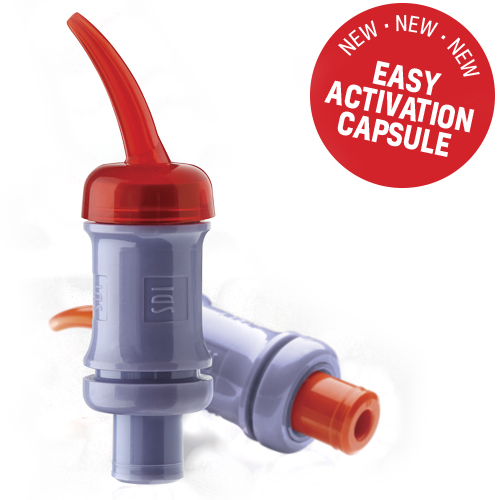
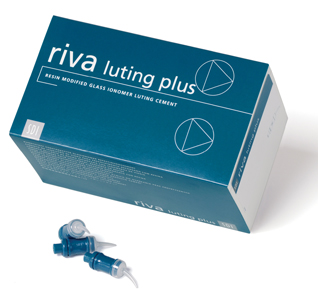
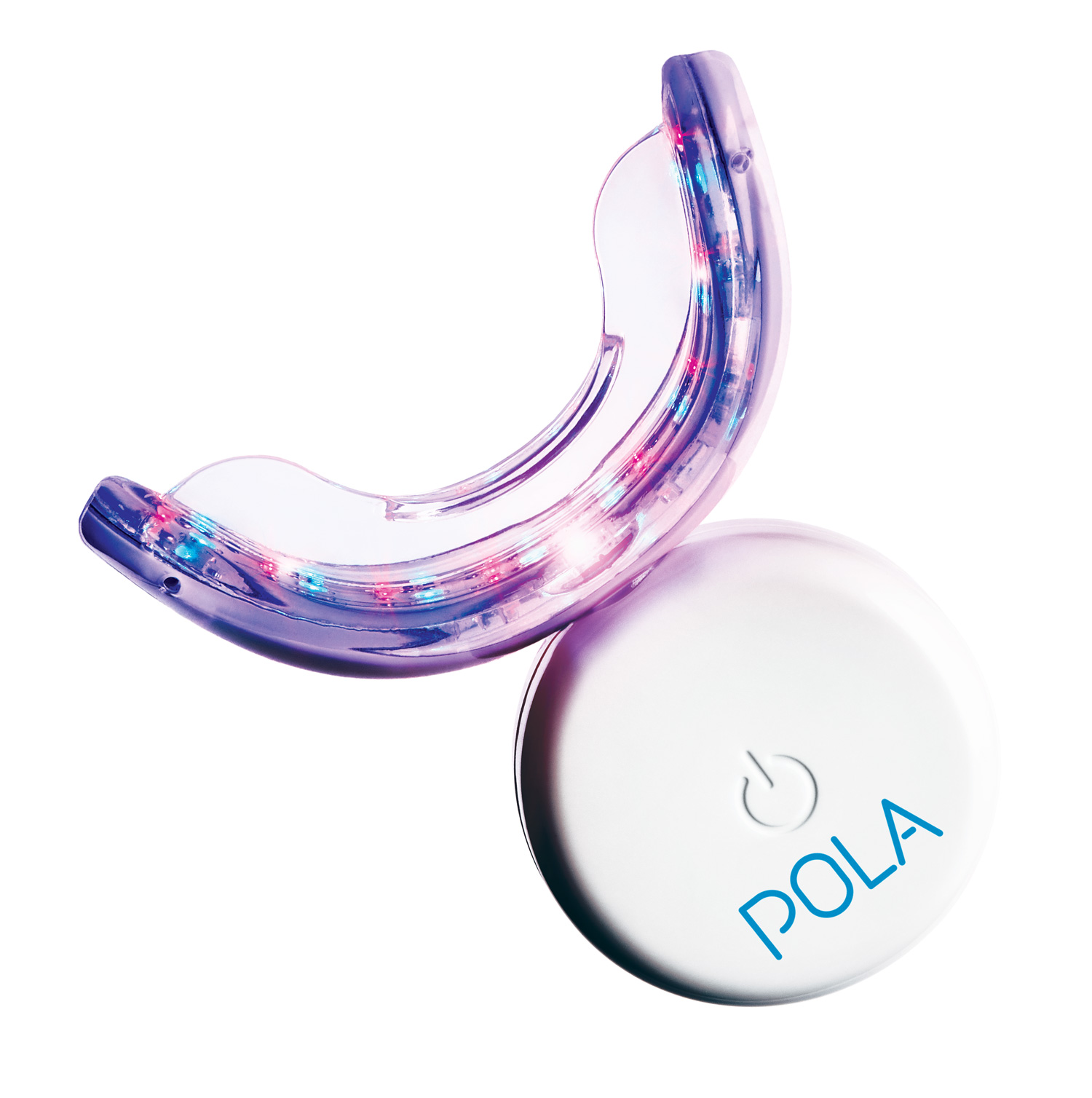
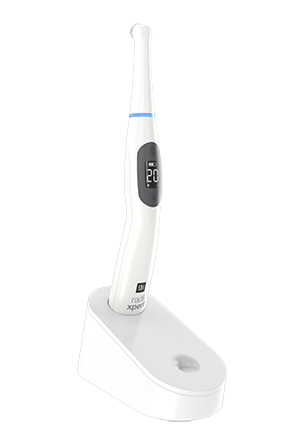
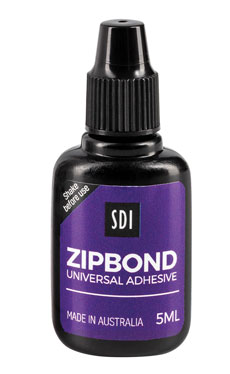


 Australia -
Australia -  New Zealand -
New Zealand - 
 United States -
United States -  Canada -
Canada -  Central/South America -
Central/South America -  Brazil -
Brazil - 
 United Kingdom -
United Kingdom -  Ireland -
Ireland -  Germany -
Germany -  France -
France -  Italy -
Italy -  Spain -
Spain -  Poland -
Poland -  Portugal -
Portugal -  Czech Republic -
Czech Republic -  Other European countries -
Other European countries - 



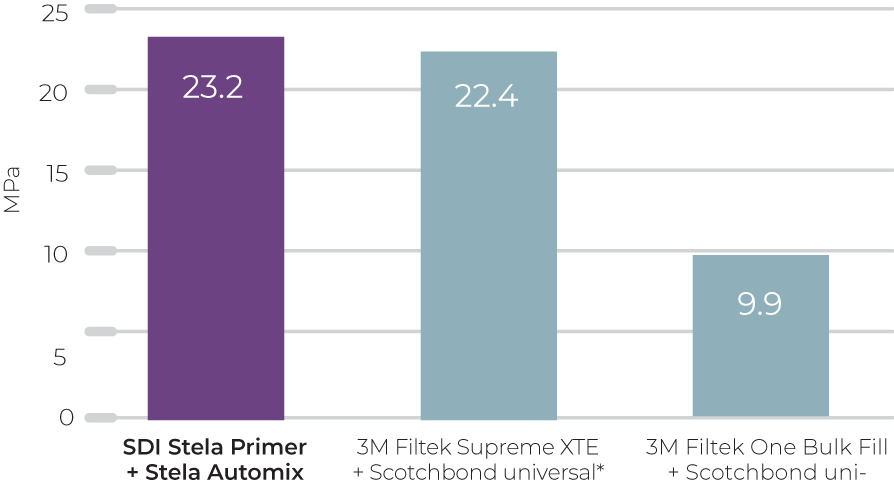
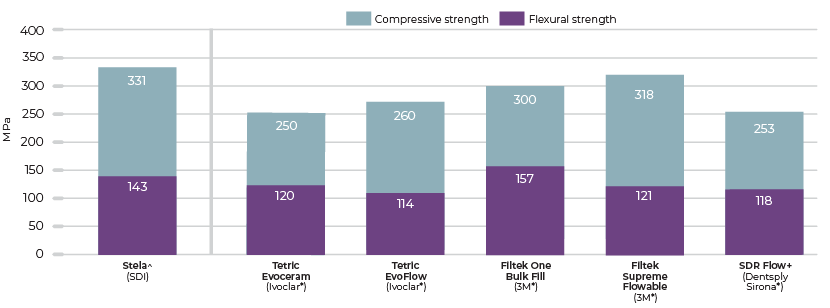
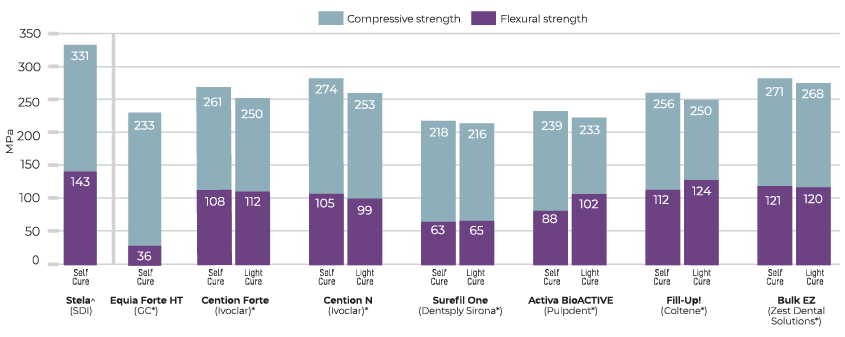
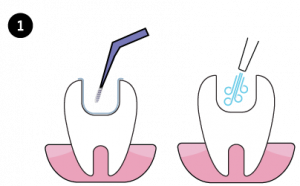
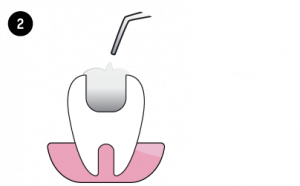
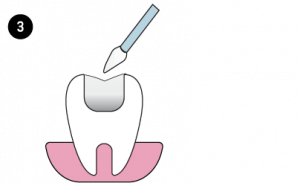

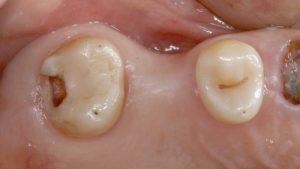 Step 1: Molar with decay
Step 1: Molar with decay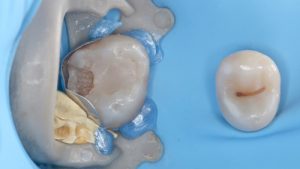 Step 2: After caries removal and isolation with rubber dam
Step 2: After caries removal and isolation with rubber dam